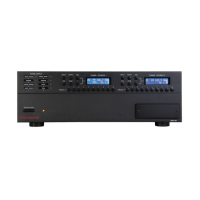MZC-88 Installation Instructions Page 23
Include Tuner preset preferences by zone. Include Paging functions. All system functions should be detailed. The person
doing the system programming isn’t necessarily the same person who sold the system or pulled the wire. Be sure every-
one involved in the installation and setup knows what the system is and how it is supposed to work.
8. ACQUIRE ALL SYSTEM COMPONENTS — Set up the system, and program and test all functions before taking the
electronics to the job site. This can save valuable time in assuring that all system components work and the system is
functioning as designed. Connecting and testing the system prior to installation will also help assure that all parts and
pieces that will go into the system are in hand, so time is spent on the job site and not running around town shopping
for parts or not being able to finish the installation while waiting for an air shipment of a ten dollar part.
9. HEAD-END CONSIDERATIONS — The system head-end should be in a convenient, central location that provides
easy access for the user, to be able to load discs, video tapes etc. The location should also be accessible for service and
ideally would have either have rear access to the system connections or a pull-out rack that allows access to system
connections. All system wire runs should terminate at the head-end. There should be sufficient mounting space for all
system components and the wires and cables that connect them. Leave plenty of room for airflow for proper ventilation
or system components could be damaged. Too tight of a space that does not leave room for system wiring or a poorly
dressed system can cause thermal problems. Wires jumbled in around system components can act as an insulator or
block free airflow which can damage the components from overheating. Incorporate a proper ventilation system using
cooling fans for systems with external amplifiers or other components that generate excess heat. When possible, leave
extra space for future expansion of the system for additional zone and source components.
10. ZONE CONSIDERATIONS — Identify all room components and their locations. Typically, a keypad would be mounted
near the entry to a room. If the room orientation of where the TV/Monitor and speakers are located leaves the keypad
behind the user, an additional IR receiver on the same wall as the TV and speakers will help make controlling the system
more user friendly. Be sure to include an appropriate wire run for the IR receiver. Additional wire runs for controlling lifts,
screens and drapes should also be considered. Try to avoid mounting keypads and IR receivers in locations that will be
exposed to direct sunlight. Leave extra wire at keypad and in-wall speaker locations so these components can be easily
removed without pulling on wires and possibly have them fall down inside the wall, should service be necessary.

